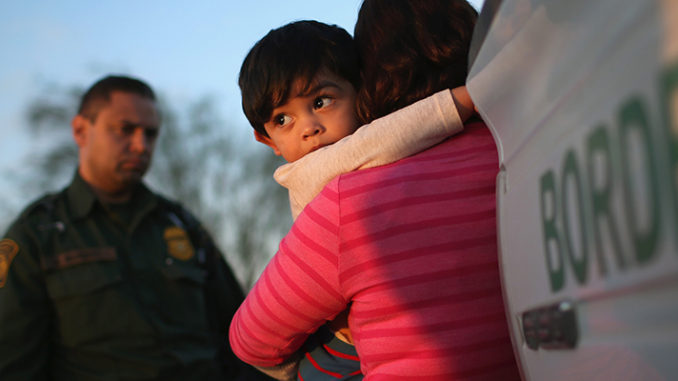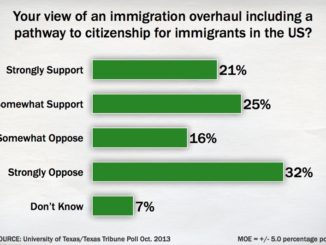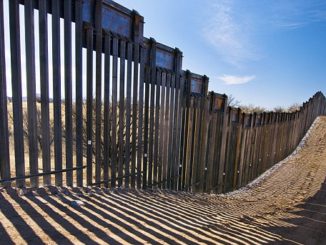
by Ernesto Castañeda
Restrictionists have long wanted the benefits of immigration, without the immigrants.
At the end of May, in another attempt to slow down the immigration of people from Central America, President Trump threatened to set tariffs on trade from Mexico. House Speaker Nancy Pelosi criticized Trump for “recklessly threatening” Mexico, “our close neighbor and friend to the South,” and even many Republicans blanched over the idea of tariffs. Under pressure from his own party, on Friday he pulled back on actually implementing the tariffs.
Such threats fit into America’s centuries-long history of excluding people of Latin American origin, whether through incendiary rhetoric or efforts to equate national borders with ethno-racial groups. In fact, immigration policy has long been marked by a central contradiction: the desire for economic and territorial growth requires an increase in the nation’s population and diversity, but white Americans fear that new groups will curtail their cultural, political and economic dominance, and so work to reduce the political voice and citizenship rights of people of color.
The Southwest has long been a space where these tensions have played out. Texas caused the first prominent rift between Mexico and the United States on March 2, 1836, when Anglo-Saxon Protestant immigrants (some of them slave owners) declared Texas’s independence from Mexico. Stephen Austin, the founder of Texas, justified the war against Mexico in racial terms: “A war of extermination is raging in Texas — a war of barbarism and of despotic principles, waged by the mongrel Spanish-Indian and negro race, against civilization and the Anglo-American race.”
Nine years later, the United States annexed Texas over Mexico’s objection. Congressional debates over annexation exposed how the desire for land clashed with the desire to limit the percentage of the American population that came from non-European origins. Sen. John C. Calhoun (S.C.) for one, acknowledged that the land would strengthen the United States, but he reminded his colleagues: “Ours, sir, is the Government of a white race. The greatest misfortunes of Spanish America are to be traced to the fatal error of placing these colored races on an equality with the white race.”
The treaty ending the war resulted in the annexation of half of Mexico: current-day California, New Mexico, Arizona, Nevada, Utah and portions of Wyoming and Colorado. The tens of thousands of people living there were promised American citizenship and full rights (resulting in some Native American and Spanish-origin people declaring, “We did not cross the border, the border crossed us.”) As a result, Latino people became a significant part of the demographic and cultural fabric of America over 170 years ago.
But lofty ideas of an inclusive “America” never matched reality, thanks to the predominance of the racist ideas advocated by the likes of Calhoun. The war instead became remembered as conquest of territory and an inferior people, ultimately diminishing the ability of these new citizens to receive equal political rights and power.
Indeed, it did not take long for the federal government to treat Latinos, both new citizens and immigrants, as unwanted outsiders. The Dillingham Commission, a congressional committee for the study of immigration that ran from 1907 to 1911, was among the first to frame immigration by less desirable groups — non-whites, Jews, Eastern Europeans, Asians — as a national problem that could be fixed by experts in the federal government. The commission’s solutions centered around a border patrol created in 1924 and decades of restrictive immigration laws that tried to give preferential treatment to Western European immigrants and their descendants.
This culture contributed to the lynching of thousands of people of Mexican origin in the West from the mid-19th century into the early 20th century. The treatment of these perceived outsiders did not improve with time: Mexican workers and Mexican-American citizens in the West and Midwest were deported in large numbers during the Great Depression, viewed as unacceptable economic competition to whites in lean times.
In this climate, politicians understood that attacking newcomers and ethnic minorities was a savvy way to advance their careers. To name but one, James Phelan, who served as both mayor of San Francisco and a congressman, made “keeping California white” a consistent and defining aspect of his political platform until his death in 1930.
This political calculus remained true for decades. In the 1990s, Gov. Pete Wilson (R-Calif.) attacked Mexican immigrants, framing them as culprits for the economic recession facing Californians at the time. Wilson’s popularity went up, and he was reelected.
But times and political calculations are changing quickly in this regard. Longer term, Wilson’s anti-Mexican tactics backfired tremendously, resulting in increased naturalization rates and higher political participation by immigrants and minorities. Now, California has better minority political representation, a progressive stance toward immigration and significant Democratic majorities in state government.
Not only is targeting immigrants of questionable political value today, it also distracts from national problems. Rather than addressing the increased cost of living, stagnant wages, increased job insecurity and growing income inequality, activists and politicians sometimes use anti-immigrant rhetoric to encourage resentment and anger, even though keeping immigrants out will do nothing to address the actual problems plaguing their constituents’ lives.
And the harm of such hateful rhetoric is significant: branding new immigrants and citizens of Latin American origin as “others” signifies that they are unassimilable and a threat to the nation. This stigma is both wrongheaded and unproductive.
An analysis of online comments sections of several news articles published in the spring of 2017 soon after Trump’s inauguration shows an increase of anti-Semitism and xenophobia targeting Latinos, Muslim refugees and asylum seekers. Over the past two years, comments posted in mainstream media outlets have even included open calls to shoot immigrants on the spot as soon as they cross the border.
We need to find ways to delegitimize these exclusionary practices against some of the most vulnerable members of our society. For most of its history, the United States has been a country of immigrants, including Latino populations. And this has proven to be a big boon, economically and culturally. For decades, the United States has attracted some of the best and the brightest from around the world, as well as those with little wealth and formal education who come hoping to build better lives with their hard work and to provide better opportunities to their American children.
A solution to the current immigration situation should not be distilled down to a negotiation over tariff threats. Rather, our debate needs to acknowledge immigrants’ humanity, something that could be done by turning the bill just passed by the House providing a path to citizenship for “dreamers” and those with Temporary Protective Status into law. Even the legislation proposed by Jared Kushner and supported by the president to increase merit-based immigration holds promise, but only if quotas limiting family reunification are removed.
Brinkmanship and threats have generated fear and division for over 200 years, and it is always counterproductive. We should accept that trying to exclude immigrants has never worked, and does far more damage than good.
Ernesto Castañeda is assistant professor at American University and author of “Building Walls: Excluding Latin People in the United States.”



